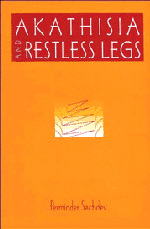Book contents
- Frontmatter
- Contents
- Foreword
- Acknowledgements
- Abbreviations
- Part I Introduction
- Part II Drug-induced akathisia
- 4 The definition of drug-induced akathisia
- 5 Epidemiology
- 6 Clinical characteristics and diagnosis of acute akathisia
- 7 Clinical characteristics of tardive and chronic akathisia
- 8 Akathisia due to a general medical condition
- 9 Assessment and measurement of akathisia
- 10 Aetiology and pathogenesis of akathisia
- 11 Treatment of drug-induced akathisia
- Part III Restless legs syndrome
- Part IV Conclusions
- Appendix A Haskovec's Akathisie
- Appendix B Prince Henry Hospital Akathisia Scale
- Appendix C Barnes (1989) Akathisia Rating Scale
- Appendix D Hillside Akathisia Scale (version 4)
- References
- Index
11 - Treatment of drug-induced akathisia
from Part II - Drug-induced akathisia
Published online by Cambridge University Press: 12 September 2009
- Frontmatter
- Contents
- Foreword
- Acknowledgements
- Abbreviations
- Part I Introduction
- Part II Drug-induced akathisia
- 4 The definition of drug-induced akathisia
- 5 Epidemiology
- 6 Clinical characteristics and diagnosis of acute akathisia
- 7 Clinical characteristics of tardive and chronic akathisia
- 8 Akathisia due to a general medical condition
- 9 Assessment and measurement of akathisia
- 10 Aetiology and pathogenesis of akathisia
- 11 Treatment of drug-induced akathisia
- Part III Restless legs syndrome
- Part IV Conclusions
- Appendix A Haskovec's Akathisie
- Appendix B Prince Henry Hospital Akathisia Scale
- Appendix C Barnes (1989) Akathisia Rating Scale
- Appendix D Hillside Akathisia Scale (version 4)
- References
- Index
Summary
The studies that have examined the treatment of akathisia will be reviewed in this chapter. Since the various subtypes of akathisia have different pathomechanisms, different treatment approaches will apply. On the other hand, the efferent limb of the neuronal pathway involved in akathisia is possibly shared by the various subtypes. Drugs that work on this aspect of the pathophysiology should, therefore, be effective in all subtypes. The published literature is not always explicit on the subtype of the akathisia syndrome being studied; this makes it necessary to draw inferences from the clinical descriptions, which in some cases are incomplete. Overall, the treatment of AA has been examined in some well-controlled studies, but the information on the treatment of TA is preliminary. I will discuss AA and TA separately.
The studies reported vary in the rigour of their methodology. Many of the earlier reports are anecdotes of individual cases, often published to highlight a promising treatment. Only some of the larger studies are controlled, and fewer still have a double-blind design and the appropriate methodology. The results of each study will, therefore, be examined in light of the methodology used, so that appropriate weight can be placed on its findings. Most studies report changes in only a proportion of patients. I will list the percent change in the studies and calculate the effect sizes for the studies with an acceptable methodology. Conclusions will be drawn from groups of studies.
- Type
- Chapter
- Information
- Akathisia and Restless Legs , pp. 251 - 292Publisher: Cambridge University PressPrint publication year: 1995
- 2
- Cited by



